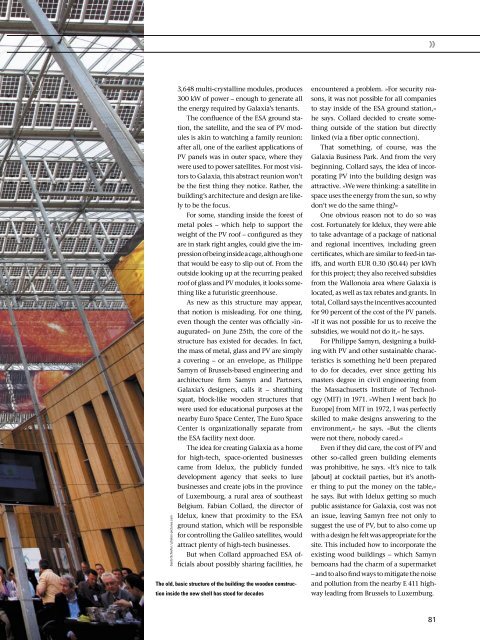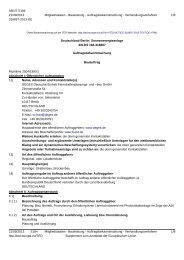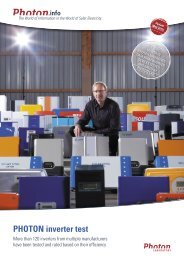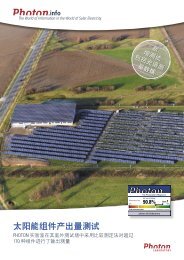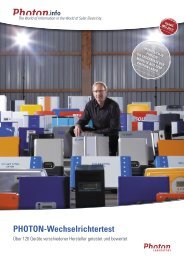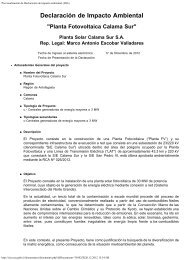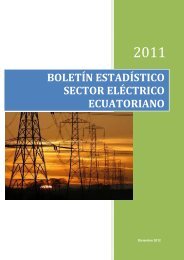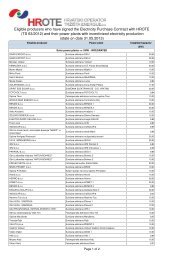INTRODUCTORY SPECIAL INTRODUCTORY ... - PHOTON Info
INTRODUCTORY SPECIAL INTRODUCTORY ... - PHOTON Info
INTRODUCTORY SPECIAL INTRODUCTORY ... - PHOTON Info
You also want an ePaper? Increase the reach of your titles
YUMPU automatically turns print PDFs into web optimized ePapers that Google loves.
Guido Schiefer / photon-pictures.com<br />
3,648 multi-crystalline modules, produces<br />
300 kW of power – enough to generate all<br />
the energy required by Galaxia’s tenants.<br />
The confluence of the ESA ground sta-<br />
tion, the satellite, and the sea of PV mod-<br />
ules is akin to watching a family reunion:<br />
after all, one of the earliest applications of<br />
PV panels was in outer space, where they<br />
were used to power satellites. For most visi-<br />
tors to Galaxia, this abstract reunion won’t<br />
be the first thing they notice. Rather, the<br />
building’s architecture and design are like-<br />
ly to be the focus.<br />
For some, standing inside the forest of<br />
metal poles – which help to support the<br />
weight of the PV roof – configured as they<br />
are in stark right angles, could give the im-<br />
pression of being inside a cage, although one<br />
that would be easy to slip out of. From the<br />
outside looking up at the recurring peaked<br />
roof of glass and PV modules, it looks some-<br />
thing like a futuristic greenhouse.<br />
As new as this structure may appear,<br />
that notion is misleading. For one thing,<br />
even though the center was officially »in-<br />
augurated« on June 25th, the core of the<br />
structure has existed for decades. In fact,<br />
the mass of metal, glass and PV are simply<br />
a covering – or an envelope, as Philippe<br />
Samyn of Brussels-based engineering and<br />
architecture firm Samyn and Partners,<br />
Galaxia’s designers, calls it – sheathing<br />
squat, block-like wooden structures that<br />
were used for educational purposes at the<br />
nearby Euro Space Center, The Euro Space<br />
Center is organizationally separate from<br />
the ESA facility next door.<br />
The idea for creating Galaxia as a home<br />
for high-tech, space-oriented businesses<br />
came from Idelux, the publicly funded<br />
development agency that seeks to lure<br />
businesses and create jobs in the province<br />
of Luxembourg, a rural area of southeast<br />
Belgium. Fabian Collard, the director of<br />
Idelux, knew that proximity to the ESA<br />
ground station, which will be responsible<br />
for controlling the Galileo satellites, would<br />
attract plenty of high-tech businesses.<br />
But when Collard approached ESA of-<br />
ficials about possibly sharing facilities, he<br />
The old, basic structure of the building: the wooden construc-<br />
tion inside the new shell has stood for decades<br />
November 2009 81<br />
»<br />
encountered a problem. »For security rea-<br />
sons, it was not possible for all companies<br />
to stay inside of the ESA ground station,«<br />
he says. Collard decided to create some-<br />
thing outside of the station but directly<br />
linked (via a fiber optic connection).<br />
That something, of course, was the<br />
Galaxia Business Park. And from the very<br />
beginning, Collard says, the idea of incor-<br />
porating PV into the building design was<br />
attractive. »We were thinking: a satellite in<br />
space uses the energy from the sun, so why<br />
don’t we do the same thing?«<br />
One obvious reason not to do so was<br />
cost. Fortunately for Idelux, they were able<br />
to take advantage of a package of national<br />
and regional incentives, including green<br />
certificates, which are similar to feed-in tar-<br />
iffs, and worth EUR 0.30 ($0.44) per kWh<br />
for this project; they also received subsidies<br />
from the Wallonoia area where Galaxia is<br />
located, as well as tax rebates and grants. In<br />
total, Collard says the incentives accounted<br />
for 90 percent of the cost of the PV panels.<br />
»If it was not possible for us to receive the<br />
subsidies, we would not do it,« he says.<br />
For Philippe Samyn, designing a build-<br />
ing with PV and other sustainable charac-<br />
teristics is something he’d been prepared<br />
to do for decades, ever since getting his<br />
masters degree in civil engineering from<br />
the Massachusetts Institute of Technol-<br />
ogy (MIT) in 1971. »When I went back [to<br />
Europe] from MIT in 1972, I was perfectly<br />
skilled to make designs answering to the<br />
environment,« he says. »But the clients<br />
were not there, nobody cared.«<br />
Even if they did care, the cost of PV and<br />
other so-called green building elements<br />
was prohibitive, he says. »It’s nice to talk<br />
[about] at cocktail parties, but it’s anoth-<br />
er thing to put the money on the table,«<br />
he says. But with Idelux getting so much<br />
public assistance for Galaxia, cost was not<br />
an issue, leaving Samyn free not only to<br />
suggest the use of PV, but to also come up<br />
with a design he felt was appropriate for the<br />
site. This included how to incorporate the<br />
existing wood buildings – which Samyn<br />
bemoans had the charm of a supermarket<br />
– and to also find ways to mitigate the noise<br />
and pollution from the nearby E 411 high-<br />
way leading from Brussels to Luxemburg.


